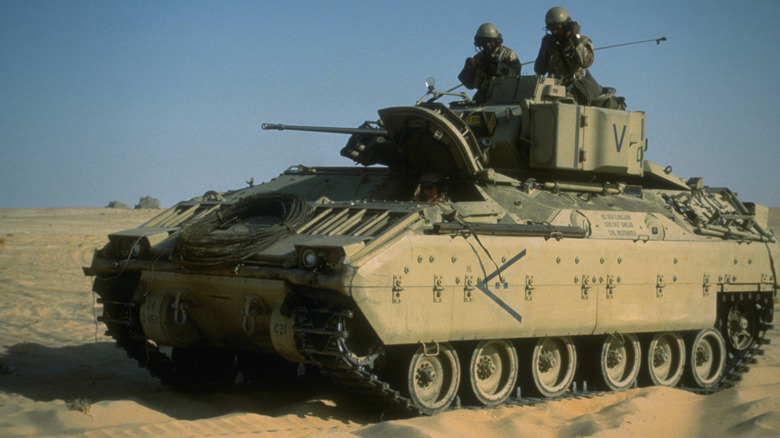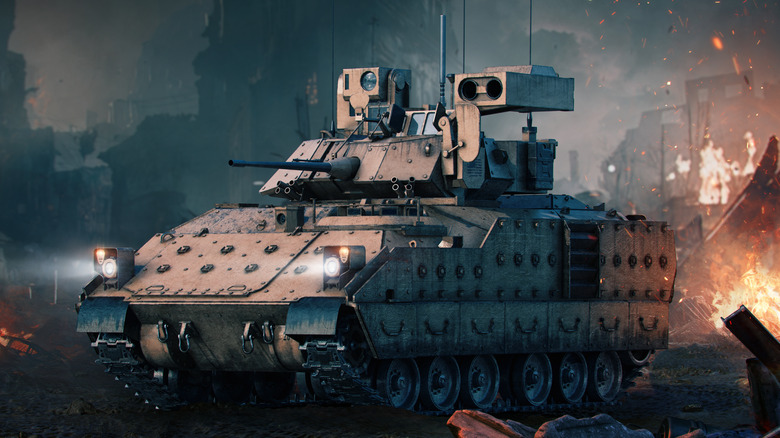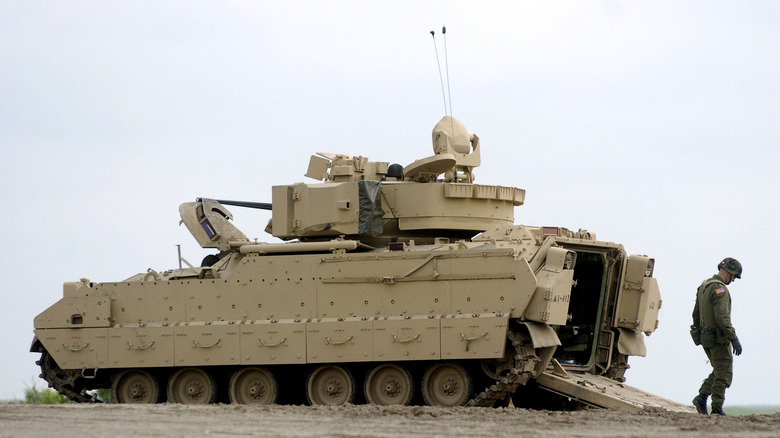The Biggest Strengths And Weaknesses Of America's Bradley Fighting Vehicle
The Bradley Fighting Vehicle is the standard infantry and scout armored transport system for the U.S. Army. First introduced in 1981 following years of development to create a vehicle capable of outgunning the Soviet Union's BMP-1, it's been incredibly successful. Since its introduction, more than 6,700 BFVs have rolled off assembly lines, while upgrades and variant vehicles have kept the Bradley family a dominating force on the world's battlefields.
There are two primary variants of the Bradley: the M2 infantry fighting vehicle and the M3 cavalry fighting vehicle. The Army uses Bradleys for various purposes, including supporting engineers, housing artillery systems, fire support, ambulance operations, command transport, and more. Since its introduction, the vehicle has supported global combat operations, in several countries including Ukraine, which operates a small force of Bradleys.
Since its introduction, numerous efforts have attempted to replace the family with equivalent or idealized superior systems, though none have succeeded. This ensured the Bradley's sustainability in combat operations, and it continues to transport troops in and out of high-risk situations. Numerous factors make the BFV one of the premiere tracked combat vehicles in operation around the world. It has numerous strengths and weaknesses that make it lethal while supporting the need for future upgrades.
The BFV packs a serious anti-tank punch
When development of the BFV began in the early 1960s, the goal was to create a new tracked armored transport vehicle capable of destroying tanks while keeping up with the M1 Abrams main battle tank's speed. While this was a tall order, the BFV delivered in many ways. The M2 features a turret containing an M242 Bushmaster 25mm autocannon capable of penetrating most armored platforms, including tanks.
Since handing some over to Ukraine, the Bradley has helped destroy a Russian T-90 tank, which is essentially what they were designed to do. While 25mm isn't a typical caliber for tank destruction, the BFV's ability to continuously fire at 100 to 500 rounds per minute makes it especially deadly up to two kilometers from a target. The BFV also houses a TOW missile system capable of taking on most armored vehicles, and it has an M240C medium machine gun and other defensive arms, including grenade launchers for deploying smoke.
Lethality isn't the BFV's sole function. It's primarily used to transport personnel. Depending on the variant, the BFV carries a crew of three to seven fully outfitted combat personnel. A BFV has a combat range of 300 miles on a tank of diesel and can travel up to 41 mph over numerous types of terrain. It has a demonstrated track record of operating in all kinds of environments around the world. Regarding its armor, the BFV protects against small arms and artillery. Despite its many positive characteristics, the BFV has some weaknesses as well.
Cost and other factors limit the BFV's effectiveness
One of the BFV's most significant weaknesses is its endurance surrounding efforts to replace it. The BFV is an effective vehicle in many environments, but the Pentagon has been trying to replace it for decades. One of the costliest attempts was the Army Future Combat Systems, which idealized replacements for the BFV and M1. While this may seem like a strength — the BFV isn't going anywhere anytime soon; cost is a consideration, and according to the International Institute for Strategic Studies, the U.S. spent $24 billion attempting to replace the BFV.
That's no small sum of money, and for various reasons, each attempt fizzled out, leaving the BFV in the Army's active inventory. Putting the cost of replacement aside, the BFV has several vulnerabilities that make it susceptible to destruction. These include a lack of defenses against anti-armor fires, guided missiles, helicopter attacks, anti-tank mines, and, in some cases, improvised explosive devices that can disable a BFV or kill and injure its personnel.
Like most tracked vehicles weighing 27+ tons, the BFV makes a lot of noise, making it all but impossible to enter an area undetected. Additionally, it has spotty radio communications in developed regions, and it isn't ideal for water crossings, though few armored vehicles are. While these limitations exist for the BFV, there's no denying its combat effectiveness and endurance despite the Pentagon's attempts to replace it. Whatever its future, the BFV is a proven combat vehicle well worth its weight in armor.


